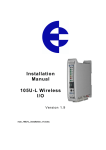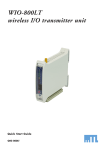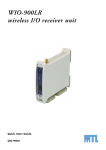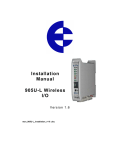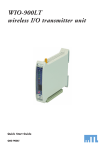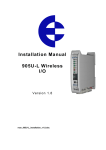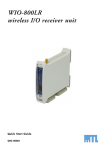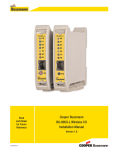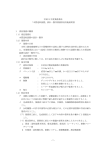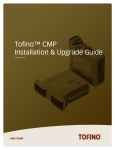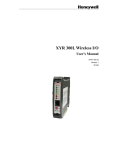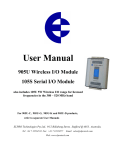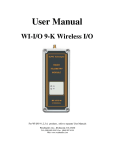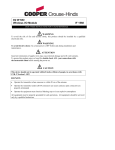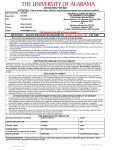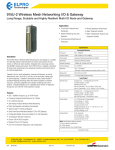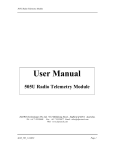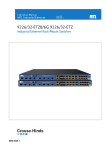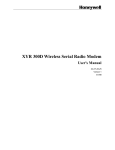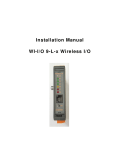Download WIO-800L Wireless I/O - MTL Instruments Group
Transcript
WIO-800L Wireless I/O User Guide INM WIO800L WIO-800L Wireless I/O This page intentionally left blank. Page 2 Jul 2010 Contents Contents __________________________________________________________________ 3 About this document ............................................................................................................................ 5 Installing your unit __________________________________________________________ 6 Unit components and connections ...................................................................................................... 7 Transmitter unit ............................................................................................................................................... 7 Receiver unit ................................................................................................................................................. 10 Installing the antenna ......................................................................................................................... 12 Supported antennas ...................................................................................................................................... 12 Radio transmission distances ........................................................................................................................ 14 Installing and earthing antennas ................................................................................................................... 15 Dipole and collinear antennas ....................................................................................................................... 16 Dipole antennas........................................................................................................................................ 16 Collinear antennas.................................................................................................................................... 16 Yagi antennas ............................................................................................................................................... 18 Installing the power supply ................................................................................................................ 20 Inputs and outputs _________________________________________________________ 21 Digital inputs .................................................................................................................................................. 22 Relay outputs ................................................................................................................................................ 23 Status outputs ............................................................................................................................................... 24 Analog input .................................................................................................................................................. 25 Thermocouple input....................................................................................................................................... 28 Pulse input .................................................................................................................................................... 29 Analog output ................................................................................................................................................ 30 Installing and configuring the unit ____________________________________________ 32 Installing the unit ................................................................................................................................ 33 Configuring your units ........................................................................................................................ 34 Testing your units .............................................................................................................................. 35 Unit specifications _________________________________________________________ 36 Transmitter unit .................................................................................................................................. 36 Receiver unit ...................................................................................................................................... 36 Ancillary hardware reference information .......................................................................................... 37 RS232 serial cable ........................................................................................................................................ 37 Index ____________________________________________________________________ 40 WIO-800L Wireless I/O This page intentionally left blank. Page 4 Jul 2010 User Manual Safety information Thank you for selecting a WIO-800L product for your telemetry needs. We trust it will give you many years of valuable service. To ensure your WIO-800L product enjoys a long life, double-check ALL your connections with the Installation Guide before powering on the module. WARNING: Incorrect termination of supply wires may cause internal damage and will void warranty. About this document This document is the WIO-800L Wireless I/O Installation Manual that describes how to install your WIO-800L units and contains important information for installing your units with other equipment. Note If your network only contains one transmitter and receiver pair, you should also read the WIO800L QuickStart Guides. This document contains the following sections: Section Read this section if you want to … Basic steps for using your unit Learn the basic steps for installing and using your unit. Factory default configuration Understand how the transmitter sends information to the receiver. Unit components Understand the different parts of your unit. Antenna installation Learn how to install an antenna with your unit. Resetting factory defaults Reset your unit to the original factory default settings. Linking transmitter and receiver units Link your units to work as a dedicated pair. Safety information Understand important safety information related to your unit. NOTE: You must read this information before installing your unit. Specifications Know technical information about your unit. For more information, see the next sections. INM WIO800L_v1.7 .doc Page 5 WIO-800L Wireless I/O Installing your unit This section describes how to install your unit and contains the following sections: Step Description For more information, see … 1 – Read the safety information Lets you understand important safety information related to your unit. Safety Information on page 5. NOTE: You must read this information before installing your unit. 2 – Get to know the unit features Understand the basic features of your unit. Unit components and connections on page 7. 3 – Install the antenna Learn how to install an antenna with your unit. Installing the antenna on page 12. 4 – Install the power supply Learn how to install a power supply for your unit. Installing the power supply on page 20. 5 – Install the units Learn how to install your unit. Installing the unit on page 33. 6 – Linking and configuring the unit Learn how to link and configure your units to transmit and receive information. Configuring your units on page 34. 7 – Test the unit Understand the principles for testing your units. Testing your units on page 35. Note To ensure internal surge protection works correctly, you must earth each unit using the Earth terminal. For more information, see the next sections. Page 6 Jul 2010 User Manual Unit components and connections This section shows the components and terminal connections for the transmitter and receiver units. Transmitter unit The WIO-800LT transmitter unit has the following components and terminal connections: Earth Wire Lug underneath Unit INM WIO800L_v1.7 .doc Page 7 WIO-800L Wireless I/O The front panel contains the following components: The triangle on the rotary switch indicates the current position, for example: Position 0 Position 3 NOTE: To avoid damaging the rotary switch, use a screwdriver to change the position. The rotary switch controls the setpoint levels on the Analog and Thermocouple inputs. Page 8 Jul 2010 User Manual The LEDs on the front panel indicate the unit status: LED Status Indicates None No power supply. OK LED Green Current status of the unit OK. OK LED Red Fault condition detected in unit. TX Led Flashes Transmitting Message. PG LED on Configuration Cable Connected. Input LED ON Input LEDS (i.e. D1, D2, SP, AZ.) light when the corresponding input is active. All LEDs medium flash INM WIO800L_v1.7 .doc D1 Digital Input 1 is active (Low). D2 Digital Input 2 is active. SP Analog Setpoint is active. AZ Analog Input is zero mA Medium speed flash (1.6HZ) indicates the module is halfway through the configuration process. Medium flash also happens when you set the rotary switch to position 0 when powering on the unit. Page 9 WIO-800L Wireless I/O Receiver unit Your WIO-800LR unit has the following components and terminal connections: DC LOAD DO 2 - - NOT USED - NOT USED DO 3 DO 2 - DO 1 + POWER SUPPLY - AO DO 1 LOAD Max. 30VDC 500mA + For inductive load, use surge diodes + LOAD SYSTEM OK COMMS FAIL COMMON + 24V + - DO 3 - AC LOAD ANALOG OUTPUT Max. analog load 900 ohm + - + POWER SUPPLY 9 – 30 VDC 250mA @ 12V 125mA @ 24V Page 10 DO contacts are rated at 1A, 250VAC For good engineering practice, use a surge diode for DC loads and a surge capacitor (10nF 250V) for AC loads Jul 2010 User Manual The front panel contains the following components: The LEDs on the front panel indicate the unit status: LED Status Indicates None No power supply. OK LED Green Current status of the unit OK. OK LED Red Fault condition detected in unit. RX Led Flashes Receiving Message. CF Led ON Module Communication Failure Output is active. PG LED on Configuration Cable Connected. Output LED ON The Output LEDS (i.e. D1, D2, D3) light when the corresponding output is active. LEDs with RSSI Push Button Pressed Output LED flashing quickly D1 Relay output D1 is ON (Contact Closed). D2 Relay Output D2 is ON. D3 Relay Output D3 is ON. When you press the RSSI push button, the unit shows the signal strength by lighting the LEDs from the bottom to the top. Signal strength is the strength of the last message received that was addressed to this station. LED Signal Strength LED Signal Strength D1 More than -85 dBm RX More than -100 dBm D2 More than -90 dBm CF More than -105 dBm D3 More than -95 dBm PG Always on during RSSI test If an output is in communication failure, the corresponding LED flashes at 5 Hz. D1 Relay Output D1 is in communication failure. D2 Relay Output D2 is in communication failure. D3 Relay Output D3 is in communication failure. PG Analog output is in communications failure. INM WIO800L_v1.7 .doc Page 11 WIO-800L Wireless I/O Installing the antenna This section explains how to install your antenna and contains the following sections: Section Description For more information, see … Supported antennas and cables Details the antennas and cables you can use with the units. Supported antennas on page 12. Radio transmission distances Details the distances for reliable operation. Radio transmission distances on page 14. Installing and earthing antennas Details important information about installing and earthing antennas. Installing and earthing antennas on page 15 Dipole and collinear antennas Details important information about using dipole and collinear antennas. Dipole and collinear antennas on page 16. Yagi antennas Details important information about using Yagi antennas. Yagi antennas on page 18. For more information, see the next sections. Supported antennas You can use the following antennas with the units: Antenna Additional information Total gain (including cable) WH900 Whip antenna for mounting directly onto the module operation up to 500m. -6 dBi ANTCFD890EL 0 dBi Dipole antenna with 15’ of Cellfoil cable and SMA connector. 0 dBi ANTSG870-6 6dBi Collinear omni-directional antenna with N-type connector. 5 dBi ANTYU6-870 10dBi Yagi directional antenna with N-type connector. 10 dBi ANTYU16-870 15dBi Yagi directional antenna with N-type connector. 15 dBi The following table shows required cable losses for different antennas when used with the WIO-800LT in Europe: Antenna Europe (transmitter) Europe (receiver) ANTCFD890EL Cable Included Cable Included ANTSG870-6 External cable with loss > 6dB Any Cable (N-Type Male to SMA Male) ANTYU6-870 External cable with loss > 10dB Any Cable (N-Type Male to SMA Male) ANTYU16-870 External cable with loss > 15dB. Any Cable (N-Type Male to SMA Male) Page 12 Jul 2010 User Manual You must carefully select antennas for WIO-800LT modules to avoid contravening the maximum power limit on the unlicensed channel. The net gain of the antenna/cable configuration should be no more than 0dB in Europe when operating on the 869.525MHz channel. Note The net gain of an antenna/cable configuration is the gain of the antenna (in dBi) less the loss in the coaxial cable (in dB). The WIO-800LR module has no limitation on antenna gain, as this module does not incorporate a radio transmitter. The following table details the gains of some typical antennas: Antenna Gain (dBi) Dipole with integral 3m cable 0 Dipole without cable 2 5dBi Collinear (3dBd) 5 8dBi Collinear (6dBd) 8 3 element Yagi 5 6 element Yagi 10 The following table details losses for typical cables: Cable Loss (dB per 10m) at 900 MHz RG58 -5 RG213 -2.5 Cellfoil -3 INM WIO800L_v1.7 .doc Page 13 WIO-800L Wireless I/O Radio transmission distances The unit will operate reliably over large distances depending on the: Antenna type; Antenna location; Amount of radio interference; and Radio path obstructions (e.g. hills or trees). Typical reliable distances are: Area Distance Additional information Europe- 500mW 5+ km 10% duty cycle limitation, no overall antenna gain permitted on transmitter. Europe – 5mW 300m Unity gain antenna configuration on transmitter, no duty cycle limit. To achieve these distance, you must elevate at least one site on a hill or transmission tower. Modules will operate reliably with some radio path obstruction; however obstructions also reduce the reliable distance. Note You must test all obstructed paths to check the reliability of the path. You can achieve maximum transmission distances if the radio path has “line of sight”. For example, raising antennas above intermediate obstructions including hills, trees, etc. Obstructions reduce the range; however they may not prevent a reliable path. The closer the obstruction is to the antenna, the greater the blocking effect. For example, a group of trees around the antenna is a larger obstruction than a group of trees further away from the antenna. You can achieve longer distances by mounting one antenna on top of a hill. Note Due to the earth’s curvature, you must elevate antennas higher than the ground level between the antennas for longer paths (greater than 3 miles / 5 km). The unit can tolerate larger amounts of obstructions for shorter distances. For very short distances, you can also mount the antennas inside buildings. If two WIO-800L modules cannot communicate reliably, you can use a high gain yagi antenna on the receiver unit. Page 14 Jul 2010 User Manual Installing and earthing antennas You must connect an antenna to each WIO-800L module using the SMA connector at the top of the enclosure. MTL recommends carefully taping the connections between the antenna and coaxial cable to prevent moisture ingress. Moisture ingress in the coaxial cable is a common cause of radio system problem as it greatly increases the radio losses. MTL recommends taping the connection with three layers of tape: Layer Tape 1 PVC tape. 2 Vulcanising tape (e.g. 3M 23 tape). 3 Additional layer of PVC UV-stabilized insulating tape. The first tape layer lets you easily inspect the joint if required as you can easily remove the vulcanising seal. Note You must effectively earth all masts for mast-mounted antennas to avoid lightning surges. We also recommend using a coaxial surge diverter for antennas mounted outside industrial plant environments. If the antenna is not already shielded from lightning strike by an adjacent earthed structure, you can provide shielding by installing a lightning rod above the antenna. You should connect the antenna to the module using 50 ohm coaxial cable (e.g. RG58 or RG213) terminated with a male coaxial connector, The higher the antenna is mounted, the greater the transmission range; however as the length of coaxial cable increases so do cable losses. For use on unlicensed frequency channels, there are several types of antenna suitable for use. If you mount antennas on elevated masts, you should effectively earth the masts to avoid lightening surges. The WIO-800L radios are fitted with surge protection. Note For high lightening risk areas, MTL recommends additional surge suppression devices. If the antenna is not already shielded from lightning strike by an adjacent earthed structure, you can install a lightening rod to provide shielding. INM WIO800L_v1.7 .doc Page 15 WIO-800L Wireless I/O Dipole and collinear antennas This section contains important information for using dipole and collinear antennas. For more information, see the next sections. Dipole antennas Unity gain dipole antennas are commonly used on unlicensed channels. The dipole antenna does not provide any gain, so the power transmitted from the antenna is the same as the power out of the module. A dipole antenna that comes supplied with integral 15 ft cable does not require additional coaxial cable. You should mount dipole antennas vertically, preferably no less than 1 metre away from a wall or mast for maximum performance. Collinear antennas Collinear antennas transmit the same amount of radio power in all directions horizontally, and are easy to install and use. They provide gain by compressing the radiated signal to a flattened disc shape, and reducing the amount of signal radiated above and below the horizontal plane. Collinear antennas are generally used at a central site with more than one remote site, or at a repeater site. Collinear antennas are similar in appearance to dipole antennas; however the antenna is longer. Collinear antennas are supplied without cable, and require additional coaxial cable. You can use collinear antennas to: Page 16 Transmitter – to compensate for the losses in long lengths of coaxial cable. Receiver – to increase receive sensitivity. Jul 2010 User Manual The following diagram shows the recommended installation for collinear and dipole antennas: INM WIO800L_v1.7 .doc Page 17 WIO-800L Wireless I/O Yagi antennas Yagi antennas are directional and have positive gain to the front of the antenna and negative gain in other directions. You can use the gain to: Compensate for coaxial cable loss for transmitter unit; and Increase receiver sensitivity for receiver units. You should install Yagi antennas with the central beam horizontal and pointed directly in the transmission direction to benefit from the antenna gain. Note Yagi antennas usually have a drain hole on the folded element. You should position the drain hole at the bottom when installing the antenna. You can install Yagi antennas: Vertically polarized – with the elements in a vertical plane; or Horizontally polarized – with the elements in a horizontal plane. The following table shows the recommended installation mode for different situations. If your installation has … MTL recommends using … Two stations both using Yagi antennas Horizontal polarization for the stations. Two or more stations communicating with a common station Vertical polarization for the stations; and Dipole or collinear (i.e. non-directional) antenna for the central station. Page 18 Jul 2010 User Manual The following diagram shows the recommended installation for collinear and dipole antennas: INM WIO800L_v1.7 .doc Page 19 WIO-800L Wireless I/O Installing the power supply The unit works with a 9-30 VDC 0.6 Amp power supply. The following table shows the power supply requirements. Power supply WIO-800LT WIO-800LR 12V 600 mA 250 mA 24V 300 mA 125 mA The power supply can be a floating supply or negatively grounded. The transmitter provides a 24V DC regulated supply for analog loop power. The supply is rated at 35 mA and should ONLY be used for powering analog loops. To install the power supply: 1. Connect the positive lead to Power Supply Input. 2. Connect the negative lead to Ground. Note To ensure internal surge protection works correctly, you must earth each unit using the Earth terminal. You should connect the module to the same ground/earth point as the antenna mounting to avoid differences in earth potential during voltage surges. Do NOT connect the positive side of the supply to Earth. 3. The following diagram illustrates the connection: Ground Page 20 Jul 2010 User Manual Inputs and outputs The units have the following inputs and outputs: Input/output WIO-800LT Digital inputs 2 Relay outputs Status outputs 2 Analog inputs 1 WIO-800LR Description For more information, see … Suitable for Voltage free contact, NPN transistor, 0-5V signal. Digital inputs on page 22. 3 250VAC 1A / 30VDC 1A. Relay outputs Important Information on page 23. 2 Max 30VDC, 500 mA. Indicate module status, communication failure and local setpoint status. Status outputs on page 24. 4-20 mA with over-range and under-range. Analog input on page 25. 0-10 mA with over-range. +24V Loop supply 1 Provides power for 1 external current loop (up to 35 mA). Installing the power supply on page 20. Analogue setpoint 1 Allows discrete setpoint to be controlled from analog input. Threshold adjustable via rotary switch. Refer to the User Manual. Thermocouple / millivolt input 1 Provides measurement of E, J, K, T type Thermocouple, millivolt signals and user-defined thermocouple types. Thermocouple input on page 28 Thermocouple setpoint 1 Lets you control discrete setpoint from thermocouple with threshold adjustable via rotary switch. Refer to the User Manual. Pulse inputs 2 Up to 10Hz. Pulse input on page 29. 0-22 mA, suitable for loop powered, floating input or single-ended input device. Analog output on page 30. Analog output 1 For more information, see the next sections. INM WIO800L_v1.7 .doc Page 21 WIO-800L Wireless I/O Digital inputs The WIO-800LT module provides two digital inputs suitable for: Voltage free contacts – e.g. mechanical switches; or NPN transistor devices – e.g. electronic proximity switches; or 0-5V signals - 2V – 4V Minimum range. Note PNP transistor devices are not suitable. The unit provides contact wetting current of approximately 5mA to maintain reliable operation of driving relays. Each digital input is connected between the appropriate Digital Input terminal and Ground. Each digital input circuit includes a LED indicator that lights when the digital input is active (i.e. when the input circuit is closed). To activate the digital input, the switching device resistance must be less than 200 ohms. Connection method Example Voltage free contact Active 0-5v signal device Page 22 Jul 2010 User Manual Relay outputs The WIO-800LR module provides three normally open voltage-free relay contacts rated at 250VAC / 30VDC 1A. You can use these outputs to directly control low-powered equipment or power larger relays for higher-powered equipment. For inductive loads, MTL recommends: DC relays - use flyback diodes across the external circuit to prevent arcing across the relay contacts. DC Load Max 30VDC AC relays – use capacitors (e.g. 10nf 250V) to prevent arcing across the relay contacts. 10nF 250V AC Load Max 250VAC 1A You can individually configure digital outputs to turn off if no command message is received by the output for a certain period. This feature provides an intelligent watchdog for each output, so communications failure at a transmitting site causes the output to revert to a known state. The output circuit is connected to the appropriate pair of Digital Output terminals. Each digital output circuit includes a LED indicator that lights when the digital output is active. The LED flashes if the watchdog alarm is active. IMPORTANT SAFETY INFORMATION In order to comply with Electrical Safety Standards, when connecting SELV AND voltages which are greater than SELV (30VAC or 60VDC) together, then Relay Output 2 must NOT be used in order to provide sufficient isolation between the outputs INM WIO800L_v1.7 .doc Page 23 WIO-800L Wireless I/O Status outputs The unit contains the following status outputs: System OK; Setpoint Output; and Communications Failure. Status outputs are FET output to common rated at 30VDC 500 mA. Connect the output circuit to the appropriate Status Output terminal. Each status output circuit is associated with an LED indicator that lights lit when the digital output is active. The following table details the status output behaviour: Status output LED LED status Description System OK active (both modules) OK Green No fault detected System OK inactive OK Red Setpoint Output (WIO-800LT) SP Green Local setpoint attached to 4-20mA analog input. Communications Failure (WIO-800LR) CF Red Watchdog alarms active on digital outputs or analog outputs. Page 24 Internal fault detected. Supply voltage Low Analog Loop supply overloaded Jul 2010 User Manual Analog input The WIO-800LT module provides one 0 - 20 mA DC analog input for connecting to instrument transducers (e.g. level, moisture, pressure transducers, etc.). Note The WIO-800LT module inputs measure down to 0mA and can also be used for zero based signals (e.g. 0 - 10 mA). The analog input has a positive and negative terminal and can be placed at any point in the current loop, providing neither input rises above the 24 volt Analog Loop Supply level. Each input has a loop resistance of less than 250 ohms and zener diode protection is provided against over-voltage and reverse voltage. Note You may require additional protection in high voltage or noisy environments or for long wiring runs. A 24VDC loop supply is available on the WIO-800LT module for powering the analog transducer loops. In this situation, connect the: Analog loop - between an Analog Input (-) terminal and Ground. Positive terminal – i.e. Analog Input (+) to the +24V Analog Loop Supply. Externally powered loops may be connected by connecting the input between "Analog Input (+)" and “Analog Input (-)” Common mode voltage may be -0.5V to 27V. MTL recommends using shielded cable for analog I/O loops to minimize induced noise and Radio Frequency Interference (RFI). Note You should only connect one end of the cable shield to Earth To connect an analog signal from a PLC or DCS output to an analog input on the WIO800LT, you must carefully check the internal circuit of the output as different devices use different ways to create an analog signal. INM WIO800L_v1.7 .doc Page 25 WIO-800L Wireless I/O The following diagrams illustrate different connection methods: Analog signal source Example 2 wire transducer 4 wire transducer Current source output Page 26 Jul 2010 User Manual Analog signal source Example Current sink output INM WIO800L_v1.7 .doc Page 27 WIO-800L Wireless I/O Thermocouple input The WIO-800LT provides one input suitable for connection to a thermocouple or a millivolt level signal. The module provides linearization tables for J, K and T type thermocouples and also supports other types via a user linearization table. Millivolt signals in the range -10mV to +100 mV are supported. For more information on configuring the thermocouple input and cold-junction compensation to suit your application, refer to the User Manual. Page 28 Jul 2010 User Manual Pulse input The WIO-800LT module lets you configure the digital inputs as pulse inputs with the following characteristics: Characteristic Value Maximum rate 10 Hz Minimum off time 20 mSec Minimum on time 20 mSec The following diagrams illustrate different connection methods: Connection method Example Passive transistor Active pulse device INM WIO800L_v1.7 .doc Page 29 WIO-800L Wireless I/O Analog output The WIO-800LR module provides a 4 - 20 mA DC analog output for connecting to instrument indicators to display remote analog measurements. The analog output is a current source provided from an internally generated +24V loop supply. When connecting to an external device (e.g. electronic indicator, recorder, PLC / DCS input, etc.) by connecting the output between the Analog Output terminal (+) and the COM terminal (–). Note Zener protection of analog outputs provides protection against short periods of overvoltage; however longer periods may result in module damage. You can also individually configure analog outputs to turn off (i.e. 0 mA) if no command message is received to the output for a certain period. The following diagrams illustrate different connection methods: Connection method Example Loop powered device Floating input device Page 30 Jul 2010 User Manual Connection method Example To singleended input device INM WIO800L_v1.7 .doc Page 31 WIO-800L Wireless I/O Installing and configuring the unit This section describes how to install and configure your unit and contains the following sections: Section Description For more information, see … Installing the unit Describes how to physically install your unit. Installing the unit on page 33. Configuring your unit Describes the different ways to configure your unit. Configuring your units on page 34. Testing your unit Describes MTL’s recommendations for testing your unit. Testing your units on page 35. For more information, see the next sections. Page 32 Jul 2010 User Manual Installing the unit To install the unit: 1. Connect signals to the supplied terminals. 2. Connect the radio antenna. 3. Install DIN rail to mount the module. 4. Clip the module to the DIN rail: You can now configure your unit. For more information, Configuring your units on page 34. INM WIO800L_v1.7 .doc Page 33 WIO-800L Wireless I/O Configuring your units You can configure your network using: Default factory configuration –enables easy setup of the network as a simple send/receive; or User-defined customized configuration – enables setting of specific information about the network. For more information on setting a user-defined customised configuration, see the User Manual. For more information on setting the factory default configuration, refer to the Quick Start Guide included with your module. The following table details the factory default configuration: Signals sent over radio WIO-800LT(Transmitter) Sends WIO-800LR (Receiver) Digital Input 1 Digital Output 1 Digital Input 2 Digital Output 2 Analog Setpoint Digital Output 3 Analog input (4-20 mA) Analog output Other signals WIO-800LT (Transmitter) WIO-800LR (Receiver) Thermocouple Input (Not used) Communication Failure (Comes on if no messages from WIO800LT) Setpoint Output (Local indication) System OK (On if system OK) Page 34 System OK (On if system OK) Jul 2010 User Manual Testing your units We recommend you bench test the complete system before installing a new system. Configuration problems are easier to identify and fix when the units are next to each other. The following table describes common problems and recommended solutions: If your installation has … You should check … MTL recommends … The antenna installation. For radio interference on the same channel. The radio path is adequate. Higher performance antennas if the path is too long. Higher mounting points to overcome obstructions. Using an intermediate unit as a repeater. Power Supply voltage Supply should be between 9 and 30VDC. Analog loop supply current The analog loop supply is rated for 35 mA max. Module configuration Your module configuration may be invalid. Re-load or restore factory default configuration. TX LED flashes but no RX LED (bench testing) Ensure the WIO-800LR is set to the same country and frequency band as the WIO800LT Register the receiver with the transmitter. (Refer to the Quick Start Guide) RX LED Flashes but no outputs change For a user-defined customized configuration, check the configuration. Check the configuration and re-program the modules. For default configuration, check the receiver is registered with the transmitter. Repeat the procedure to register the receiver with the transmitter. Poor radio channel communications TX LED flashes but no RX LED Output LEDs flash quickly Red OK LED For support for other testing issues, please contact MTL. INM WIO800L_v1.7 .doc Page 35 WIO-800L Wireless I/O Unit specifications This section details the specifications for each unit. Transmitter unit Input/output Number Additional information Digital inputs 2 Dry-contact digital inputs slow-pulsed at 10Hz. All inputs are suitable for voltage free contacts (e.g. mechanical switches) or NPN transistor devices (e.g. electronic proximity switches). NOTE: PNP transistor device inputs are NOT suitable. Status outputs 2 Separate System OK and Setpoint Status Analog inputs 1 Thermocouple inputs 1 0-20mA differential input; 16-bit resolution, 0.1% accuracy, 10 ohm input impedance. J, K or T type thermocouple with on-board cold-junction compensation. Cold junction compensation accuracy ±1º over ambient temp range: -40º to +60ºC. Power supply 1 9-30 VDC, 0.6 Amp power supply. Transmitter 1 5 mW or 500 mW DFSK Fixed Frequency Transmitter. Frequency 869.525 MHz 500 mW - 5km out of plant, 1km obstructed environment. 869.875MHz 5 mW – 1km out of plant. 300m obstructed environment Receiver unit Input/output Number Additional information Digital outputs 3 Voltage-free contacts rated at 250 VAC, 1A, 30VDC 1A 2 for digital inputs and 1 for setpoint. Status outputs 2 Separate System OK and communication failure output. Analog output 1 16-bit resolution, 0.1% accuracy, single-ended source output. Power supply 1 9-30 VDC 0.25 Amp power supply. Radio receiver 1 High sensitivity DFSK Fixed Frequency receiver. Frequency 869.525 MHz Actual frequency range depends on Paired Transmitter. 869.875MHz Sensitivity Page 36 -111 dBm At PER 8%. Jul 2010 User Manual Ancillary hardware reference information This section contains reference information about additional hardware components you may need for your unit. RS232 serial cable You can connect the unit to a PC using an RS-232 serial cable to: Transfer configuration information; Perform factory and field-testing. The serial port is an 8 pin RJ-45 plug that communicates using standard RS-232 signals: Signal information Value Baud rate 9600 Bits 8 bits with 1 stop bit Parity No parity MTL supplies a green configuration cable wired to the following pin-out: Note The following pin-out information is for reference only. RJ-45 Required Signal name Normal colour DB9 1 Ring Indicator Green / White 9 2 Data Carrier Detect Green 1 3 Y Data Terminal Ready Orange / White 4 4 Y Signal Common Blue 5 5 Y Receive Data (from Modem) Blue / White 2 6 Y Transmit Data (to Modem) Orange 3 7 Clear to Send Brown / White 8 8 Request to Send Brown 7 INM WIO800L_v1.7 .doc Page 37 WIO-800L Wireless I/O Index 2 wire transducer ..................................................... 26 4 wire transducer .................................................... 26 AC relays ................................................................. 23 active pulse device ................................................. See active signal device ................................................. 22 analog input ............................................................. 25 analog output ........................................................... 30 antennas .................................................................. 16 compatible cables ............................................... 12 dipole .................................................................. 16 installing .............................................................. 14 polarization .......................................................... 18 supported antennas ............................................ 12 arcing ....................................................................... 23 bench testing ........................................................... 35 cable loss ...................................................................... 13 cables for antennas ........................................................ 12 CFD890EL ............................................................... 12 coaxial surge diverter .............................................. 15 configuration default factory...................................................... 34 user-defined customized ..................................... 34 configuring ............................................................... 34 connections taping .................................................................. 15 current sink output ................................................... 27 current source output ............................................... 26 DC relays ................................................................. 23 DCS ......................................................................... 25 digital inputs............................................................. 22 DIN rail .................................................................... 33 dipole antennas ....................................................... 16 electronic proximity switches ................................... 22 floating input device ................................................. 30 flyback diodes .......................................................... 23 gain net gain ............................................................... 13 horizontal polarization .............................................. 18 installing .................................................................. 33 instrument transducers ............................................ 25 interference.............................................................. 14 internal surge protection .......................................... 20 LEDs receiver ............................................................... 11 transmitter ............................................................. 9 lightening rod ........................................................... 15 lightening strike........................................................ 15 line of sight .............................................................. 14 Page 38 linearization tables ................................................... 28 loop powered device ................................................ 30 maximum transmission distance .............................. 14 mechanical switches ................................................ 22 millivolt signal .......................................................... 28 net gain .................................................................... 13 obstructions ............................................................. 14 intermediate ........................................................ 14 over-voltage ............................................................. 25 passive transistor ..................................................... 29 pin-out...................................................................... 37 PLC ......................................................................... 25 polarization .............................................................. 18 polarized .................................................................. 18 power supply ........................................................... 20 installing .............................................................. 20 problems .................................................................. 35 pulse input ............................................................... 29 PVC tape ................................................................. 15 Radio Frequency Interference ................................. 25 receiver components ......................................................... 10 front panel ........................................................... 11 LEDs ................................................................... 11 terminal connections ........................................... 10 relay outputs ............................................................ 23 reliable path ............................................................. 14 reverse voltage ........................................................ 25 RFI ........................................................................... 25 RJ-45 ....................................................................... 37 rotary switch .............................................................. 8 changing position .................................................. 8 setpoint levels ....................................................... 8 RS-232 .................................................................... 37 serial cable .............................................................. 37 setpoint thermocouple ...................................................... 21 setpoint levels ............................................................ 8 SG900-6 .................................................................. 12 SG900EL ................................................................. 12 shielding .................................................................. 15 signals ..................................................................... 34 single-ended input device ........................................ 31 SMA connector ........................................................ 15 solutions .................................................................. 35 specifications ........................................................... 36 status outputs .......................................................... 24 surge diverter ........................................................... 15 surge protection ....................................................... 15 surge suppression ................................................... 15 Jul 2010 User Manual switches electronic proximity ............................................. 22 switches mechanical .......................................................... 22 taping connections................................................... 15 testing ...................................................................... 35 thermocouple ........................................................... 28 thermocouple setpoint ............................................. 21 transducers .............................................................. 25 transmitter components........................................................... 7 front panel ............................................................. 8 INM WIO800L_v1.7 .doc terminal connections ............................................. 7 UV-stabilized tape ................................................... 15 vertical polarization .................................................. 18 voltage free contact ................................................. 22 vulcanising tape ....................................................... 15 watchdog alarm ....................................................... 23 WH900..................................................................... 12 YU16/900................................................................. 12 YU6/900................................................................... 12 zener diode protection ............................................. 25 zero based signals ................................................... 25 Page 39 MTL Instruments Pty Limited 9 /12 Billabong Street Stafford Queensland 4053 Australia Tel: + 61 1300 308 374 Fax: + 61 1300 308 463 E-mail: [email protected] Cooper Crouse-Hinds Japan KK MT Building 3F 2-7-5 Shiba Daimon Minato-ku Tokyo Japan 105-0012 Tel: +81 (0)3 6430 3128 Fax: +81 (0)3 6430 3129 E-mail: [email protected] Cooper Electric (Shanghai) Co. Ltd. Room 2001, China Life Tower 16 Chao Yang Men Wai Street Chao Yang District, Beijing China 100020 Tel: + 86 10 5980 0288 Fax: + 86 10 8562 5725 E-mail: [email protected] Cooper Crouse-Hinds Korea 12F, Vision Tower 707-2 Yeoksam-dong, Gangnam-gu Seoul 135-080 South Korea Tel: +82 2 3484 6795 Fax: +82 2 3484 6778 MTL Instruments sarl Les Carrés du Parc 10 rue des Rosiéristes 69410 Champagne au Mont d’Or France Tel: +33 (0)4 78 64 98 32 Fax: +33 (0)4 78 35 79 41 E-mail: [email protected] MTL Instruments GmbH An der Gümpgesbrücke 17 D-41564 Kaarst Germany Tel: +49 (0)2131 718930 Fax: +49 (0)2131 7189333 E-mail: [email protected] MTL India No. 36, Nehru Street Off Old Mahabalipuram Road Sholinganallur Chennai - 600 119 India Tel: + 91 (0)44 24501660/24501857 Fax: + 91 (0)44 24501463 E-mail: [email protected] MTL Italia srl Via Cantù 11 I - 20092 Cinisello Balsamo MI Italy Tel: +39 (0)2 61802011 Fax: +39 (0)2 61294560 E-mail: [email protected] Group Internet home page http://www.mtl-inst.com/ Members of The MTL Instruments Group MTL Instruments BV MTL Instruments BV Terheijdenseweg 465 4825BK Breda The Netherlands Tel: +31(0)76 7505360 Fax: +31(0)76 7505370 E-mail: [email protected] Cooper Crouse-Hinds Pte Ltd. No.2 Serangoon North Avenue 5 #06-01 Fu Yu Building Singapore 554911 Tel: +65 6 487 7887 Fax: +65 6 487 7997 E-mail: [email protected] MTL Instruments Villa No. 4, Sector 2-17, Street 6 PO Box 53234, Abu Dhabi, UAE Tel: +971 2 446 6840 Fax: +971 2 446 6841 E-mail: [email protected] Measurement Technology Limited Great Marlings, Butterfield, Luton, Beds England LU2 8DL Tel: +44 (0)1582 723633 Fax: +44 (0)1582 422283 E-mail: [email protected] Cooper Crouse-Hinds MTL Inc 3413 N. Sam Houston Parkway W. Suite 210 Houston TX 77086 USA Tel: +1 281 571 8065 Fax: +1 281 571 8069 E-mail: [email protected]








































